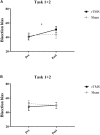Transcranial Magnetic Stimulation of Posterior Parietal Cortex Modulates Line-Length Estimation but Not Illusory Depth Perception
- PMID: 31191393
- PMCID: PMC6540782
- DOI: 10.3389/fpsyg.2019.01169
Transcranial Magnetic Stimulation of Posterior Parietal Cortex Modulates Line-Length Estimation but Not Illusory Depth Perception
Abstract
Transcranial Magnetic Stimulation (TMS) may affect attentional processing when applied to the right posterior parietal cortex (PPC) of healthy participants in line with neuropsychological and neuroimaging evidence on the neural bases of this cognitive function. Specifically, the application of TMS to right PPC induces a rightward attentional bias on line length estimation in healthy participants (i.e., neglect-like bias), mimicking the rightward bias shown by patients with unilateral spatial neglect after damage of the right PPC. With the present study, we investigated whether right PPC might play a crucial role in attentional processing of illusory depth perception, given the evidence that a rightward bias may be observed in patients with neglect during perception of the Necker Cube (NC). To this end, we investigated the effects of low-frequency rTMS applied to the right or left PPC on attentional disambiguation of the NC in two groups of healthy participants. To control for the effectiveness of TMS on visuospatial attention, rTMS effects were also assessed on a frequently used line length estimation (i.e., the Landmark Task or LT). Both groups also received sham stimulation. RTMS of the right or left PPC did not affect NC perception. On the other hand, rTMS of the right PPC (but not left PPC) induces neglect-like bias on the LT, in line with previous studies. These findings confirm that right PPC is involved in deployment of spatial attention on line length estimation. Interestingly, they suggest that this brain region does not critically contribute to deployment of visuospatial attention during attentional disambiguation of the Necker Cube. Future investigations, targeting different areas of fronto-parietal circuits, are necessary to further explore the neuro-functional bases of attentional contribution to illusory depth perception.
Keywords: landmark task; necker cube; posterior parietal cortex; rTMS; visuospatial attention.
Figures



Similar articles
-
Hemispheric Asymmetry in TMS-Induced Effects on Spatial Attention: A Meta-Analysis.Neuropsychol Rev. 2024 Sep;34(3):838-849. doi: 10.1007/s11065-023-09614-2. Epub 2023 Sep 22. Neuropsychol Rev. 2024. PMID: 37736863 Free PMC article. Review.
-
Hunting for right and left parietal hot spots using single-pulse TMS: modulation of visuospatial perception during line bisection judgment in the healthy brain.Front Psychol. 2014 Oct 31;5:1238. doi: 10.3389/fpsyg.2014.01238. eCollection 2014. Front Psychol. 2014. PMID: 25400612 Free PMC article.
-
Callosal anisotropy predicts attentional network changes after parietal inhibitory stimulation.Neuroimage. 2021 Feb 1;226:117559. doi: 10.1016/j.neuroimage.2020.117559. Epub 2020 Nov 13. Neuroimage. 2021. PMID: 33189929 Free PMC article.
-
Structural Organization of the Corpus Callosum Predicts Attentional Shifts after Continuous Theta Burst Stimulation.J Neurosci. 2015 Nov 18;35(46):15353-68. doi: 10.1523/JNEUROSCI.2610-15.2015. J Neurosci. 2015. PMID: 26586822 Free PMC article.
-
Modulation of attention functions by anodal tDCS on right PPC.Neuropsychologia. 2015 Jul;74:96-107. doi: 10.1016/j.neuropsychologia.2015.02.028. Epub 2015 Feb 23. Neuropsychologia. 2015. PMID: 25721567 Review.
Cited by
-
Unilateral Spatial Neglect After Stroke: Current Insights.Neuropsychiatr Dis Treat. 2020 Jan 10;16:131-152. doi: 10.2147/NDT.S171461. eCollection 2020. Neuropsychiatr Dis Treat. 2020. PMID: 32021206 Free PMC article. Review.
-
Hemispheric Asymmetry in TMS-Induced Effects on Spatial Attention: A Meta-Analysis.Neuropsychol Rev. 2024 Sep;34(3):838-849. doi: 10.1007/s11065-023-09614-2. Epub 2023 Sep 22. Neuropsychol Rev. 2024. PMID: 37736863 Free PMC article. Review.
-
Preoperative Applications of Navigated Transcranial Magnetic Stimulation.Front Neurol. 2021 Jan 22;11:628903. doi: 10.3389/fneur.2020.628903. eCollection 2020. Front Neurol. 2021. PMID: 33551983 Free PMC article. Review.
-
Current Status of Neuromodulation-Induced Cortical Prehabilitation and Considerations for Treatment Pathways in Lower-Grade Glioma Surgery.Life (Basel). 2022 Mar 22;12(4):466. doi: 10.3390/life12040466. Life (Basel). 2022. PMID: 35454957 Free PMC article. Review.
-
Modulation of Motor Awareness: A Transcranial Magnetic Stimulation Study in the Healthy Brain.Brain Sci. 2023 Oct 7;13(10):1422. doi: 10.3390/brainsci13101422. Brain Sci. 2023. PMID: 37891791 Free PMC article.
References
-
- Bisiach E., Berti A. (1995). “Consciousness in dyschiria,” in The Cognitive Neurosciences, ed. Gazzniga M. (Cambridge, MA: MIT Press; ).
-
- Bisiach E., Vallar G. (2000). “Unilateral neglect in humans,” in Handbook of Neuropsychology, eds Boller F., Grafman J., Rizzolatti G. (Amsterdam: Elsevier Science; ), 459–502.

